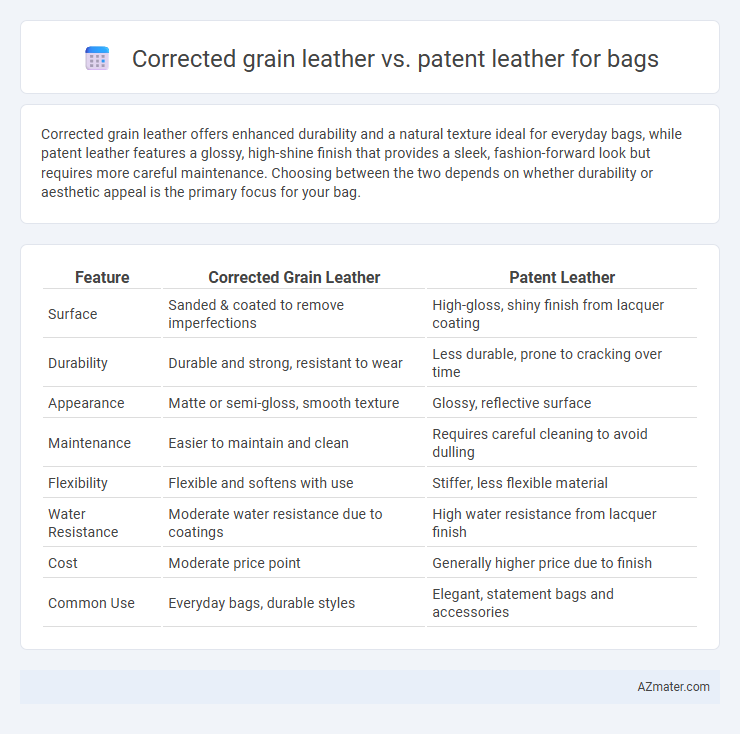Corrected grain leather offers enhanced durability and a natural texture ideal for everyday bags, while patent leather features a glossy, high-shine finish that provides a sleek, fashion-forward look but requires more careful maintenance. Choosing between the two depends on whether durability or aesthetic appeal is the primary focus for your bag.
Table of Comparison
| Feature | Corrected Grain Leather | Patent Leather |
|---|---|---|
| Surface | Sanded & coated to remove imperfections | High-gloss, shiny finish from lacquer coating |
| Durability | Durable and strong, resistant to wear | Less durable, prone to cracking over time |
| Appearance | Matte or semi-gloss, smooth texture | Glossy, reflective surface |
| Maintenance | Easier to maintain and clean | Requires careful cleaning to avoid dulling |
| Flexibility | Flexible and softens with use | Stiffer, less flexible material |
| Water Resistance | Moderate water resistance due to coatings | High water resistance from lacquer finish |
| Cost | Moderate price point | Generally higher price due to finish |
| Common Use | Everyday bags, durable styles | Elegant, statement bags and accessories |
Overview: Understanding Corrected Grain Leather and Patent Leather
Corrected grain leather features a sanded and embossed surface to mask imperfections, offering a matte finish and enhanced durability ideal for everyday bag use. Patent leather, treated with a high-gloss coating, provides a shiny, reflective appearance that resists water but may be less breathable and prone to scuffs. Choosing between these materials depends on the desired aesthetic, maintenance level, and functional requirements of the bag.
Appearance and Finish: Matte vs Glossy Surfaces
Corrected grain leather features a matte finish with a subtle texture that showcases natural grain patterns, providing a sophisticated and understated appearance ideal for classic bag designs. Patent leather boasts a highly glossy surface achieved through a lacquer coating, offering a sleek, reflective look that makes bags stand out with a polished, high-shine effect. While corrected grain leather emphasizes durability and a refined matte aesthetic, patent leather prioritizes visual impact with its smooth, mirror-like gloss.
Durability: Which Leather Lasts Longer?
Corrected grain leather features a buffed surface coated with pigment, making it more resistant to scratches and stains, which enhances its durability over time. Patent leather, characterized by its glossy polyurethane or lacquer finish, offers excellent water resistance but tends to crack and peel with prolonged use. For longevity in bags, corrected grain leather generally outlasts patent leather due to its tougher, more flexible structure and superior resistance to everyday wear and tear.
Maintenance and Care Requirements
Corrected grain leather requires regular conditioning and cleaning to maintain its texture and prevent cracking, as its surface is sanded and coated, making it less breathable but more resistant to wear. Patent leather, coated with a glossy finish, demands careful wiping with a damp cloth to avoid surface cracking and scuff marks, and it should be kept away from heat sources to preserve its shine. Both materials benefit from storage in a cool, dry place within dust bags to extend the bag's lifespan and maintain its appearance.
Water Resistance and Stain Protection
Corrected grain leather offers moderate water resistance and can be treated with additional coatings to enhance its stain protection, making it suitable for everyday bags exposed to light moisture. Patent leather, with its glossy, polymer-coated finish, provides superior water resistance and excellent stain protection, ensuring the bag remains clean and shiny in wet or dirty conditions. For bags requiring maximum durability against water and stains, patent leather is the preferred material due to its impermeable surface and ease of cleaning.
Flexibility and Comfort in Everyday Use
Corrected grain leather offers superior flexibility compared to patent leather, making it ideal for bags used daily, as it softens and molds to the shape of the contents over time. Patent leather, characterized by its glossy, rigid finish, provides less comfort and tends to be stiffer, potentially causing discomfort during prolonged use. For everyday bags requiring ease of movement and comfort, corrected grain leather delivers enhanced durability and a more supple feel that adapts with wear.
Cost Comparison: Price Points and Value
Corrected grain leather bags typically cost less than patent leather due to the additional processing required to create the patent leather's glossy finish, which increases manufacturing expenses. Patent leather offers a high-shine, resistant surface that justifies its higher price point by combining durability with a distinctive aesthetic. Consumers seeking long-term value often weigh patent leather's premium cost against corrected grain leather's affordability and more natural texture.
Suitable Styles and Occasions for Each Leather
Corrected grain leather, prized for its durability and rich texture, suits casual to semi-formal bag styles such as tote bags, messenger bags, and satchels, making it ideal for everyday use and professional settings. Patent leather, with its glossy, polished finish, is perfect for evening bags, clutches, and formal handbags, complementing elegant or dressy occasions like parties, weddings, and upscale events. Each leather's unique characteristics influence the aesthetic and functional appeal of the bag, aligning with distinct fashion statements and event requirements.
Sustainability and Environmental Impact
Corrected grain leather involves sanding and refinishing hides, often masking surface imperfections with chemical coatings, which can lead to higher environmental impact due to volatile organic compounds (VOCs) used in processing. Patent leather features a glossy, plasticized finish applied to the surface, raising concerns about non-biodegradable synthetic materials and potential microplastic pollution. Choosing bags made from sustainably sourced or alternative eco-friendly leathers can reduce carbon footprint, water usage, and chemical pollution compared to conventional corrected grain and patent leather manufacturing.
Choosing the Right Leather for Your Bag
Corrected grain leather offers durability and a natural texture ideal for everyday bags that require resistance to wear and tear. Patent leather provides a glossy, polished finish perfect for stylish, formal bags but requires careful maintenance to avoid scratches. Choosing the right leather depends on balancing the desired aesthetic with the bag's intended use and care routine.

Infographic: Corrected grain leather vs Patent leather for Bag
 azmater.com
azmater.com